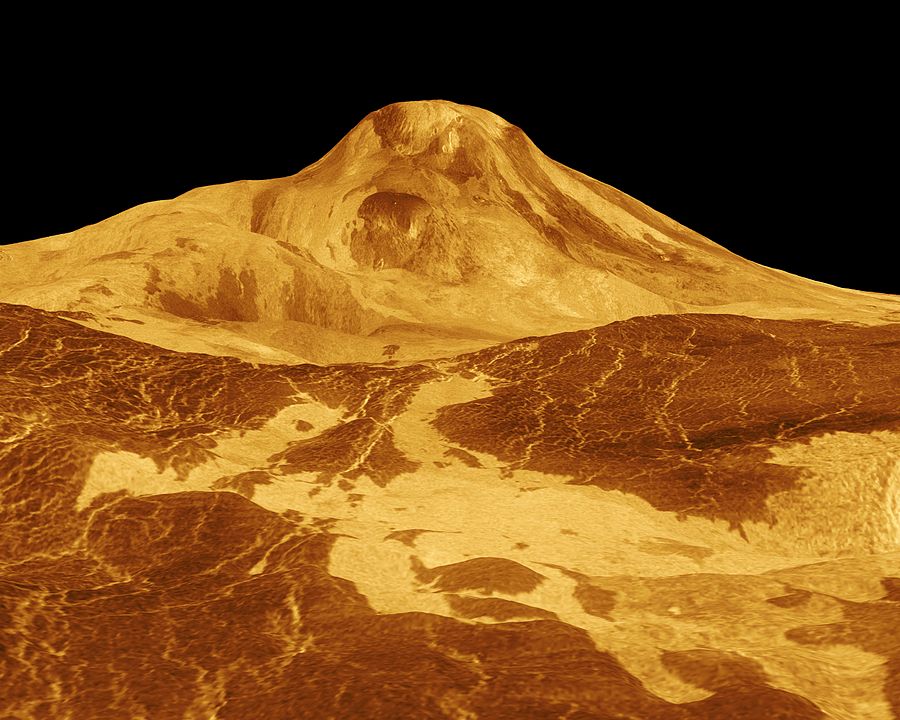There’s a lot we don’t know about the planet nearest to us. Venus is shrouded in clouds, making speculation about what’s happening on its surface a parlor game for many planetary scientists for decades. But one idea that always seems to come up in those conversations – volcanoes. It’s clear that Venus has plenty of volcanoes – estimates center around about 85,000 of them in total. However, science is still unclear as to whether there is any active volcanism on Venus or not. A new set of missions to the planet will hopefully shed some light on the topic – and a new paper from researchers from Europe looks at how we might use information from those missions to do so.
The authors break the question of whether there is active volcanism on Venus into two distinct approaches. First, can Venus maintain its current atmospheric composition without adding gases from volcanic sources? Second, is there any evidence for “transient” effects that would only be possible if active volcanoes existed?
Let’s explore the first approach first. One major data point to consider with this approach is the variability of sulfur dioxide in the atmosphere over periods as long as decades. Some researchers have pointed to this variability as clear evidence of volcanism. Still, some take a more nuanced view and point out that the variability could be caused by unknown surface-atmosphere interactions or even interactions between two layers of the atmosphere itself.
Transient effects in the atmosphere could include any number of features, ranging from water vapor to particulate matter (e.g., volcanic ash). So far, data collected on this has been limited and mainly done with remote sensing missions. However, at least a few of the new missions to Venus will involve taking data as they descend through the atmosphere.
One of those – DAVINCI – plans to take measurements in situ in the atmosphere. It will come with a couple of spectrometers, inertial measurement units, and high-tech cameras to collect data in the planet’s lower atmosphere. The spectrometers themselves should be able to directly and clearly detect trace volcanic gases in the atmosphere. Ionic concentrations, such as the deuterium/hydrogen ratio, would also indicate ongoing volcanic outgassing.
But what about gases higher up in the atmosphere? EnVision, another mission, will specialize in that area of the planet using different types of near-IR and ultraviolet spectroscopy. It might help solve some mysteries in Venus’ cloud tops, including where an unknown reservoir of sulfur dioxide is located, as it seems to be a feedstock to an unknown process taking place in the clouds that defies current modeling efforts.
Though it is beyond the scope of the current paper, another potentially interesting sensor on a cloud-based platform would be an infrasound sensor – as it would be able to directly detect pressure differences caused by volcanic eruptions. Unfortunately, no current planned mission would maintain position in the atmosphere for long enough for such a sensor to do its work, though a few have been proposed in recent years.
There’s still going to be a long wait time before any of these analytical techniques can be put to good use. Of the three main missions heading to Venus shortly, the earliest – DAVINCI – isn’t planned to launch for at least another five years, with arrival at Venus a few years later. That’s plenty of time for theorists to fine-tune their ideas about what the mission might find. And hopefully, it will help us answer the question of volcanism on our closest neighbor once and for all.
Learn More:
Wilson et al. – Possible Effects of Volcanic Eruptions on the Modern Atmosphere of Venus
UT – Potentially Active Volcanoes Have Been Found on Venus
UT – We Now Have a Map of all 85,000 Volcanoes on Venus
UT – Volcanoes on Venus May Still Be Active
Lead Image:
Maat Mons Volcano on Venus
Credit – NASA / JPL

